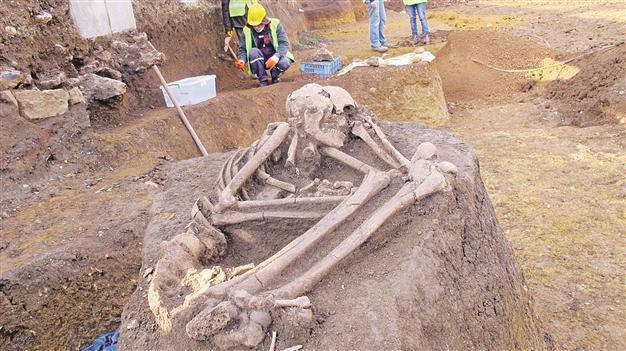Ruins from Neolithic age found in Istanbul
Ömer Erbil ISTANBUL / Radikal

Excavations reveal that the ancient residents placed mussel shells below their houses to provide permeability. The remains in the graveyard, meanwhile, were found in the fetal position. Radikal photo, Ömer ERBİL
Workers helping to upgrade Istanbul’s Marmaray railway project have discovered the priceless ruins of a Neolithic settlement dating back well over eight millennia in the city’s Pendik district.
The 8,500-year-old foundations of ancient houses, cemeteries and various tools such as spoons, needles and axes were found during the construction process of the Gebze-Haydarpaşa section of the Marmaray. The Istanbul Archaeology Museum is currently leading a dig to shed light on the district’s past inhabitants.
Culture and Tourism Provincial Manager Ahmet Emre Bilgili said discovering the ancient history of Istanbul, which dates back thousands of years, was a cause for great joy, adding that a new museum was required for the discoveries belonging to the Neolithic period.
The excavations revealed that the ancient residents placed mussel shells below their houses in order to provide permeability. Likewise, a waste area found in the site indicated that the ancient residents consumed a great deal of seafood, according to archaeological officials.
Researchers also discovered personal effects in the cemeteries, including axes, spoons, needles, presses to grind barley and wheat, ground stones, fire stones and some pottery dating back to the Byzantine period. The remains in the graveyard, meanwhile, were found in the fetal position.
The ancient site is located 1.5 kilometers east of Pendik’s district center and about 50 meters northwest of a bay on the coast.
Previous excavations The site was discovered during railroad construction in 1908. The first scientific excavation of the area was conducted in 1961 by Professor Şevket Aziz Kansu, during which a limited amount of data was obtained on the ancient settlement.
Another excavation was conducted in the area in April 1981 because a mound had been severely damaged due to new construction.
Specialists returned to the area in 1992 for new excavations, revealing three settlement layers. In the upper layer, a surface containing many pots and pans belonging to the classical age was found, while eroded architectural remnants and cemeteries were found in the middle layer. On the lowest level, researchers discovered evidence of settlement from the Neolithic age.
Previously, another ancient city with similar features was discovered in Istanbul’s Yenikapı neighborhood. Officials from the Archaeology Museum said they were currently working to determine where there was any relationship between the residents of the two sites.
